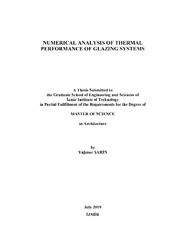Please use this identifier to cite or link to this item:
https://hdl.handle.net/11147/7492| Title: | Numerical Analysis of Thermal Performance of Glazing Systems | Other Titles: | Cam Sistemlerinin Isıl Performansının Sayısal Analizi | Authors: | Şahin, Yağmur | Advisors: | Başaran, Tahsin | Keywords: | Thermal performance Glazing systems Heat transfer Thermal analysis |
Publisher: | Izmir Institute of Technology | Source: | Şahin, Y. (2019). Numerical analysis of thermal performance of glazing systems. Unpublished master's thesis, İzmir Institute of Technology, İzmir, Turkey | Abstract: | Thermal performance of different glazing systems have been investigated with a
comprehensive parametric study numerically. In order to analyze the heat transfer
through the windows, CFD simulations have been performed considering many
affecting parameters. The aim of the study is to determine the appropriate window
configurations according to the different cities that have different climatic conditions of
Turkey which are: Ağrı, Sivas, Amasya and İskenderun. For this purpose, the glazing
part of the window has been analyzed because of having low thermal resistance due to
the gap widths, temperature differences and the emissivity values.
Four physical models of glazing systems were designed. The thickness of
glazing units is 4 mm and the height is 1 m as a constant. For investigating the effect of
the cavity dimension on the heat transfer, two gap widths usually used, are determined
and combined in different ways which as 12–12 mm, 16–16 mm, 12–16 mm and 16–12
mm. Different boundary conditions are defined according to ambient temperature of
inside and outside. Radiation heat transfer is included in the calculations and various
low-e coatings are defined to analyze the radiation effect on the heat transfer coefficient.
As a result of this study, temperature and velocity profiles are different in all
scenarios. The effect of gap width on the U-value is more distinguished in the low
temperature difference. Heat loss can be minimized significantly with using low-e
material and the emissivity value is more effective on the wider gap widths. It is also
shown that the optimum air layer thickness of the triple pane window differ from the
temperature difference significantly. The highest U-values were obtained in 12-12 mm
gap width glass. It was determined that the heat losses can be reduced by using 16-12
mm gap width glass about 2% and 8% in cold regions and in warm regions respectively. Pencere camlarından kaynaklanan ısı kayıplarının binaların enerji performansına etkisi enerji verimliliği konusunda dikkate alınması gereken bir meseledir. Bu çalışmanın amacı cam sistemlerinin ısıl performansını çeşitli parametreler üzerinden incelemektir. Kapsamlı bir ısı transfer analizi için CFD simülasyon metodu kullanılmıştır. Amaç farklı iklim şartlarına sahip Türkiye’de bulunan 4 şehrin; Ağrı, Sivas, Amasya ve İskenderun’un ortalama kış sıcaklıklarına göre belirlenen koşullarda, ısıl performans açısından en uygun pencere şeklini belirlemektir. Çalışmada üçlü cam sistemi üzerinden gerçekleşen ısı transferi ve cam boşluklarındaki akış incelenmiştir. Bunun için 4 farklı fiziksel model oluşturulmuştur. Cam ünitelerin kalınlıkları 4 mm, yükseklikleri ise 1 m olarak belirlenmiştir. Cam üniteleri arasındaki boşluğun ısı transferine etkisini değerlendirmek için uygulama alanlarında en çok tercih edilen 12 ve 16 mm’lik boşluk genişlikleri seçilip 4 farklı şekilde bir araya getirilmiştir. Belirlenen senaryolar 12-12 mm, 16-16 mm, 12-16 mm ve 16-12 mm boşluk genişliğine sahip üçlü camlardır. Dıştaki ve içteki sıcaklık durumlarına göre çeşitli sınır koşulları belirlenmiştir. Cam yüzeyler arasındaki boşlukta 1 atmosfer başınçta kuru hava olduğu varsayılmıştır ve havanın özellikleri ortalama sıcaklığa göre belirlenmiştir. Radyasyon ile gerçekleşen ısı transferi hesaplamalara dahil edilmiştir. Farklı değerlerde düşük yayınım kaplamaları cam yüzeylerine tanımlanarak, radyasyonun ısı transferine etkisi gösterilmiştir. Bu çalışmanın sonunda, literatürdeki benzer çalışmalarda da gösterildiği gibi boşluk genişliğini 12 mm’den sonra arttırmak U değerinde önemli bir azalışa sebep olmamaktadır. Boşluk genişliğinin ısı transferindeki etkisi düşük sıcaklık farklarında daha çok fark edilir. Cam yüzeylerin emissivite değerini düşürmek ısı transfer miktarını önemli ölçüde azaltır ve büyük boşluk genişliklerinde daha etkilidir. Bu nedenle düşük emissivite kaplamalı camlarda en yüksek U değerleri 12-12 mm boşluk genişlikli camlarda elde edilmiş ve 16-12 mm boşluk genişliğine sahip cam kullanılarak soğuk bölgelerde ısı kayıplarının 2% ve sıcak bölgelerde ise 8% oranında azaltılabileceği gösterilmiştir. |
Description: | Thesis (Master)--Izmir Institute of Technology, Architecture, Izmir, 2019 Includes bibliographical references (leaves: 71-75) Text in English; Abstract: Turkish and English |
URI: | https://hdl.handle.net/11147/7492 |
| Appears in Collections: | Master Degree / Yüksek Lisans Tezleri |
Files in This Item:
| File | Description | Size | Format | |
|---|---|---|---|---|
| T002051.pdf | MasterThesis | 5.91 MB | Adobe PDF |  View/Open |
CORE Recommender
Page view(s)
172
checked on Mar 10, 2025
Download(s)
658
checked on Mar 10, 2025
Google ScholarTM
Check
Items in GCRIS Repository are protected by copyright, with all rights reserved, unless otherwise indicated.